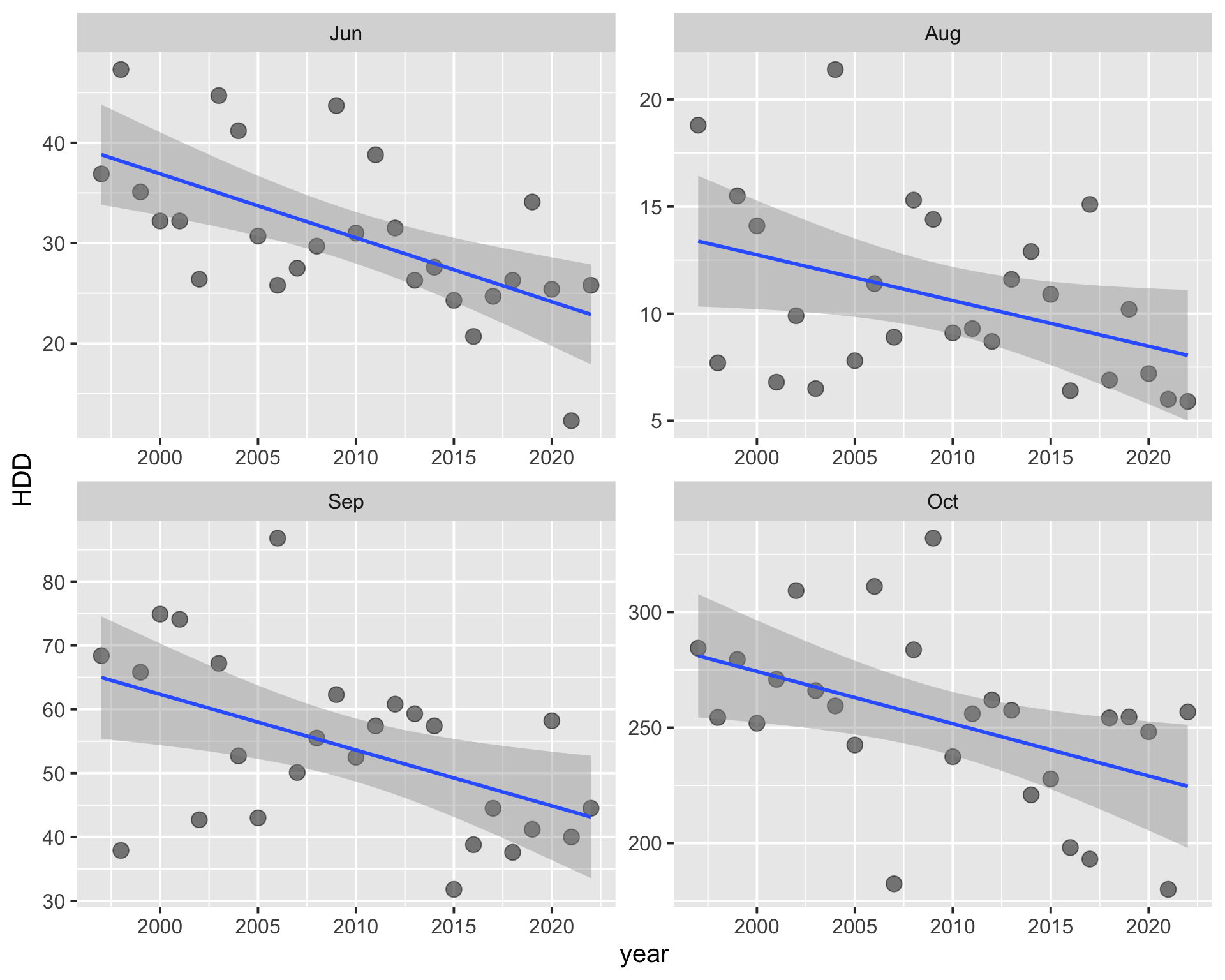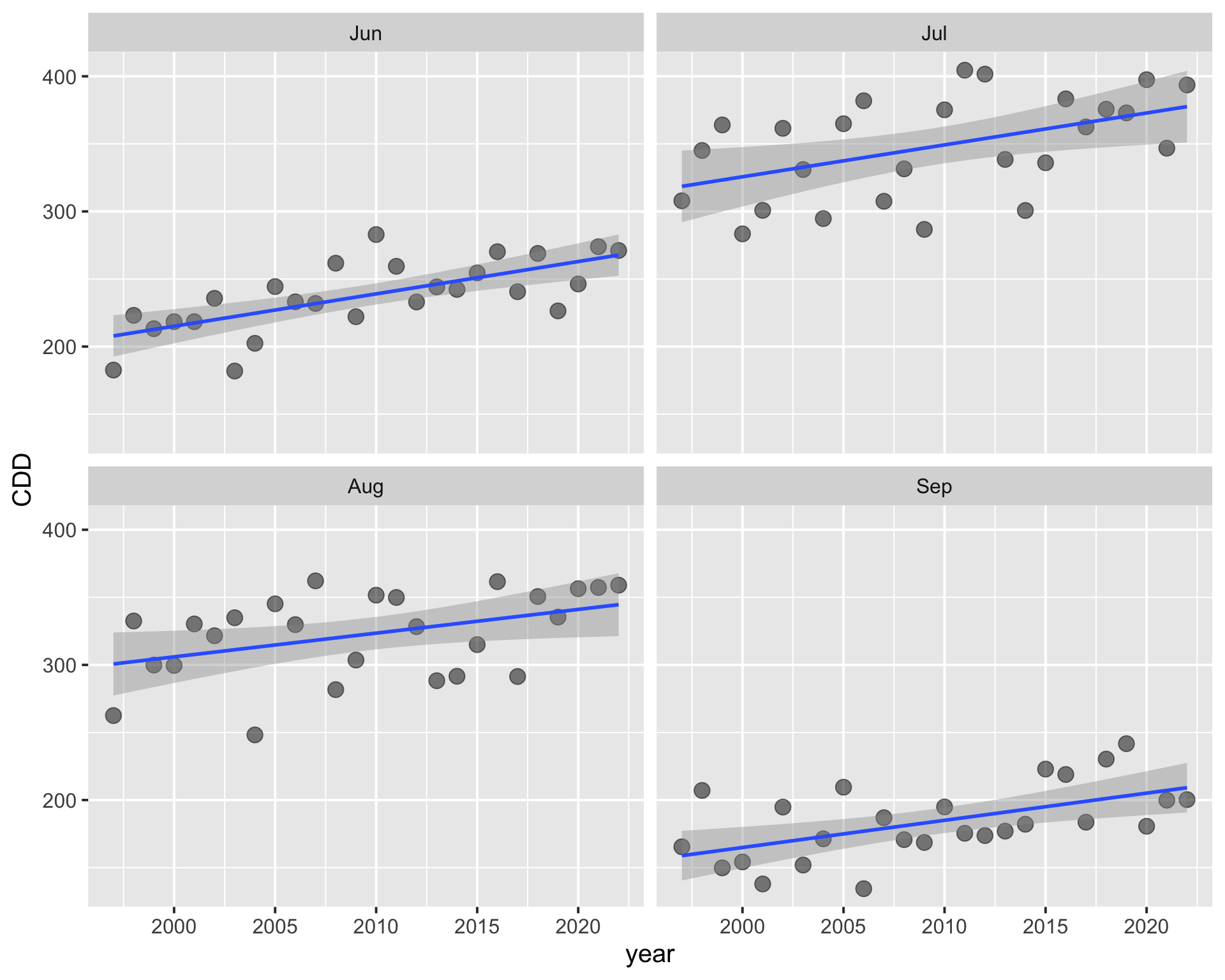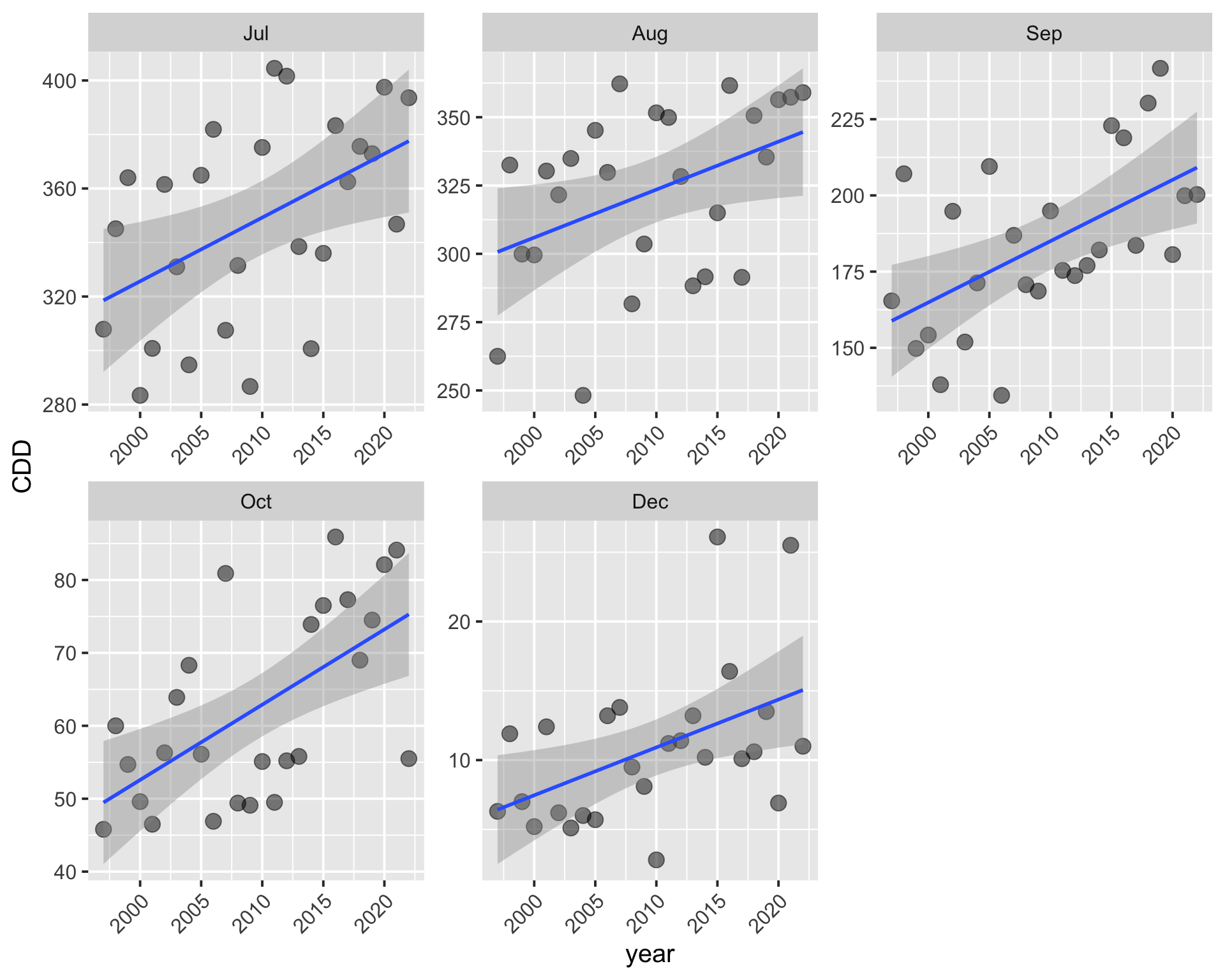Introduction
Degree days are useful as a measure of building heating and cooling demands. A degree day is calculated as the difference between the average temperature (the average of the high and low temperature for the day) and a reference temperature (in the US 65°F is used). For example, if the average temperature today is 40°F, that would be 25 heating degree days (HDD). A summer day with an average temperature of 85°F would have 20 cooling degree days (CDD). Degree days are usually well correlated with the amount of energy used to heat or cool a home.
I was interested in obtaining and analyzing degree day data; in particular I wanted to see if there were any noticeable trends over time. Given an overall increase in earth’s average temperature due to climate change, I would hypothesize that there might be an overall increase in CDD and a decrease in HDD.
Changes in heating or cooling degree days would have implications for the amount of energy needed in the future to heat and cool residential or commercial buildings, resulting changes in demand on the electric grid, and implications for related carbon emissions (either for the power grid or from burning fossil fuels to heat buildings).
Data
I obtained heating and cooling degree day data from the U.S. Energy Information Administration for the US. Note these data are weighted by population, to reflect the effect of both temperature and population on energy demands for cooling and heating. You can see details of how the EIA data are calculated here.
I’ll only use years we have complete data for (1997-2022). Table 1 shows the data after being loaded and cleaned up.
Code
region <- "u_s"
dd <- read_csv(paste0('data/EIA_DegreeDays_Monthly_',region,'.csv'),
skip = 4,
show_col_types = FALSE) |>
janitor::clean_names() |>
rename(CDD = paste0('cooling_degree_days_',region,
'_cooling_degree_days_cooling_degree_days')) |>
rename(HDD = paste0('heating_degree_days_',region,
'_heating_degree_days_heating_degree_days')) |>
mutate(date = lubridate::my(month)) |>
select(-month) |>
mutate(month = lubridate::month(date)) |>
mutate(year = lubridate::year(date)) |>
filter(year > 1996, year < 2023) # keep only complete yearsI’ll also make a dataframe of the yearly totals (Table 2)
Analysis
Heating Degree Days
Figure 1 shows the distribution (using a boxplot) of US heating degree days for each month. Not surprisingly HDD tends to be higher in winter months, although there is a decent amount of variability between years.
HDD Per Month
Code

Trends in HDD
Is there a trend in HDD over time? I would expect that HDD might decrease over time due to climate change and the increase in earth’s average temperature.
Annual
Figure 2 shows a timeseries of the annual total heating degree days in the US, along with a linear regression line that shows a negative trend.
Code
g <- dd_yearly |>
ggplot(aes(year, HDD)) +
geom_point(size = 4, alpha = 0.5) +
geom_smooth(method = 'lm', formula = 'y~x') +
labs(title = "US Annual Heating Degree Days")
plotly::ggplotly(g)Code
There is a fair bit of variability, but looking at the fit metrics (Table 3) shows that the negative trend in HDD is statistically significant (p-value < 0.05). Annual heating degree days are decreasing at a rate of 13 HDD per year.
Monthly
We have seen that there is a negative trend in annual HDD; what are the trends for individual months? Figure 3 shows timeseries of monthly HDD vs year for winter months, with linear regression lines plotted over them. Visually there appears to be a negative trend for some of the months.
Code
dd |>
filter(month %in% c(11,12,1,2,3,4)) |>
mutate(month_name = lubridate::month(date, label = TRUE)) |>
ggplot(aes(year, HDD, group = month_name)) +
geom_point(size = 3, alpha = 0.5) +
geom_smooth(method = 'lm', formula = 'y ~ x') +
facet_wrap('month_name', scales = 'free') +
guides(x = guide_axis(angle = 45))
To better quantify these trends I want to fit a linear regression to the data for each month and examine the results. This could be done with a for loop, but I will take advantage of a nice nested workflow using the tidyr (Wickham, Vaughan, and Girlich 2023), broom (Robinson, Hayes, and Couch 2023), and purrr (Wickham and Henry 2023) packages.
Code
dd_fit_hdd <- dd |>
group_by(month) |>
nest() |>
mutate(fit = map(data, ~ lm(HDD ~ year, data = .x) ),
tidied = map(fit, broom::tidy),
glanced = map(fit, broom::glance)
) |>
unnest(tidied) |>
ungroup()
dd_fit_hdd |>
mutate_if(is.numeric, ~round(.x,digits = 3)) |>
DT::datatable(rownames = FALSE, options = list(pageLength = 5))Now that the data and model fit results are in a tidy dataframe (Table 4), they can be easily filtered to identify significant fits using p-values (Table 5). The months with significant trends are June, August, September, and October. These months and the linear regression lines are shown in Figure 4
Code
Code
dd |>
filter(month %in% c(6,8,9,10)) |>
mutate(month_name = lubridate::month(date, label = TRUE)) |>
ggplot(aes(year, HDD, group = month_name)) +
geom_point(size = 4, alpha = 0.5) +
geom_smooth(method = 'lm', formula = 'y ~ x') +
facet_wrap('month_name', scales = 'free') 
Cooling Degree Days
CDD Per Month
Figure 5 shows the distribution of US heating degree days for each month. Not surprisingly CDD tends to be higher in summer months, although there is a decent amount of variability between years.
Trends in CDD
Annual
Is there a trend in CDD over time? I would expect that CDD might increase over time due to climate change and the increase in earth’s average temperature.
Figure 6 shows a timeseries of the annual total heating degree days in the US, along with a linear regression line showing a positive trend.
Code
g <- dd_yearly |>
ggplot(aes(year, CDD)) +
geom_point(size = 4, alpha = 0.5) +
geom_smooth(method = 'lm', formula = 'y~x') +
labs(title = "US Annual Cooling Degree Days")
plotly::ggplotly(g)Code
Looking at the fit metrics shows that the positive trend in CDD is indeed statistically significant (Table 6), with CDD increasing at a rate of 12.28
Monthly
Figure 7 shows timeseries of monthly CDD vs year for the 4 summer months with the highest CDD, with linear regression lines plotted over them. Visually there appears to be a positive trend for each month.
Code
dd |>
filter(month %in% c(6,7,8,9)) |>
mutate(month_name = lubridate::month(date, label = TRUE)) |>
ggplot(aes(year, CDD, group = month_name)) +
geom_point(size = 4, alpha = 0.5) +
geom_smooth(method = 'lm', formula = 'y ~ x') +
facet_wrap('month_name')
Next I’ll apply a linear regression to each month using the same workflow used for HDD.
There are significant positive trends in CDD for July, August, September, October, and December (Table 7). Figure 8 shows the data and fits for these months in detail.
Code
Code
dd |>
filter(month %in% c(7,8,9,10,12)) |>
mutate(month_name = lubridate::month(date, label = TRUE)) |>
ggplot(aes(year, CDD, group = month_name)) +
geom_point(size = 4, alpha = 0.5) +
geom_smooth(method = 'lm', formula = 'y ~ x') +
facet_wrap('month_name', scales = 'free') +
guides(x = guide_axis(angle = 45))
Summary
Annual and monthly heating and cooling degree days for the US 1997-2022 were analyzed. A linear regression was applied to the annual data, and to each month, to determine if there was a trend. Model fits with a p-value less than 0.05 were considered significant.
There is a negative trend in annual HDD (Figure 2, Table 3), with HDD decreasing at a rate of 13.2 HDD per year.
There is a positive trend in annual CDD (Figure 6, Table 6), with CDD increasing at a rate of 12.28 CDD per year.
There are significant negative trends in HDD for the months of June, August, September, and October (Table 5).
There are significant positive trends in CDD for the months of July, August, September, October, and December (Table 7).
Future Research Questions
Implications for energy use
- How much actual energy use (kWh, therms, etc.) corresponds to a degree day? This will depend on many factors, but we could make a rough estimate by comparing degree days to energy demand or consumption.
SessionInfo
R version 4.4.1 (2024-06-14)
Platform: x86_64-apple-darwin20
Running under: macOS Sonoma 14.7.2
Matrix products: default
BLAS: /Library/Frameworks/R.framework/Versions/4.4-x86_64/Resources/lib/libRblas.0.dylib
LAPACK: /Library/Frameworks/R.framework/Versions/4.4-x86_64/Resources/lib/libRlapack.dylib; LAPACK version 3.12.0
locale:
[1] en_US.UTF-8/en_US.UTF-8/en_US.UTF-8/C/en_US.UTF-8/en_US.UTF-8
time zone: America/Denver
tzcode source: internal
attached base packages:
[1] stats graphics grDevices datasets utils methods base
other attached packages:
[1] plotly_4.10.4 DT_0.33 broom_1.0.7 janitor_2.2.1
[5] lubridate_1.9.4 forcats_1.0.0 stringr_1.5.1 dplyr_1.1.4
[9] purrr_1.0.2 readr_2.1.5 tidyr_1.3.1 tibble_3.2.1
[13] ggplot2_3.5.1 tidyverse_2.0.0
loaded via a namespace (and not attached):
[1] gtable_0.3.6 xfun_0.50 bslib_0.8.0 htmlwidgets_1.6.4
[5] lattice_0.22-6 tzdb_0.4.0 vctrs_0.6.5 tools_4.4.1
[9] crosstalk_1.2.1 generics_0.1.3 parallel_4.4.1 pkgconfig_2.0.3
[13] Matrix_1.7-1 data.table_1.16.4 lifecycle_1.0.4 compiler_4.4.1
[17] farver_2.1.2 munsell_0.5.1 snakecase_0.11.1 htmltools_0.5.8.1
[21] sass_0.4.9 yaml_2.3.10 lazyeval_0.2.2 pillar_1.10.1
[25] crayon_1.5.3 jquerylib_0.1.4 cachem_1.1.0 nlme_3.1-166
[29] tidyselect_1.2.1 digest_0.6.37 stringi_1.8.4 splines_4.4.1
[33] labeling_0.4.3 fastmap_1.2.0 grid_4.4.1 colorspace_2.1-1
[37] cli_3.6.3 magrittr_2.0.3 withr_3.0.2 scales_1.3.0
[41] backports_1.5.0 bit64_4.5.2 timechange_0.3.0 rmarkdown_2.29
[45] httr_1.4.7 bit_4.5.0.1 hms_1.1.3 evaluate_1.0.3
[49] knitr_1.49 viridisLite_0.4.2 mgcv_1.9-1 rlang_1.1.4
[53] glue_1.8.0 renv_1.0.9 rstudioapi_0.17.1 vroom_1.6.5
[57] jsonlite_1.8.9 R6_2.5.1 